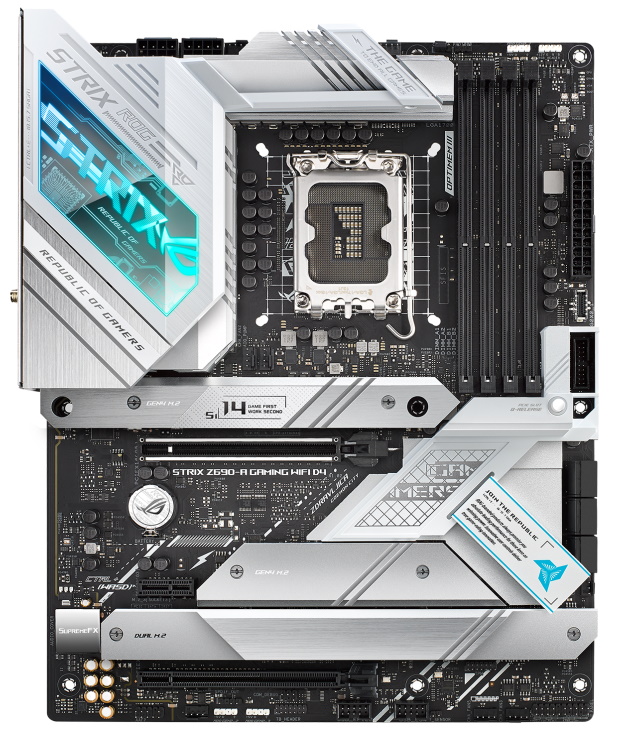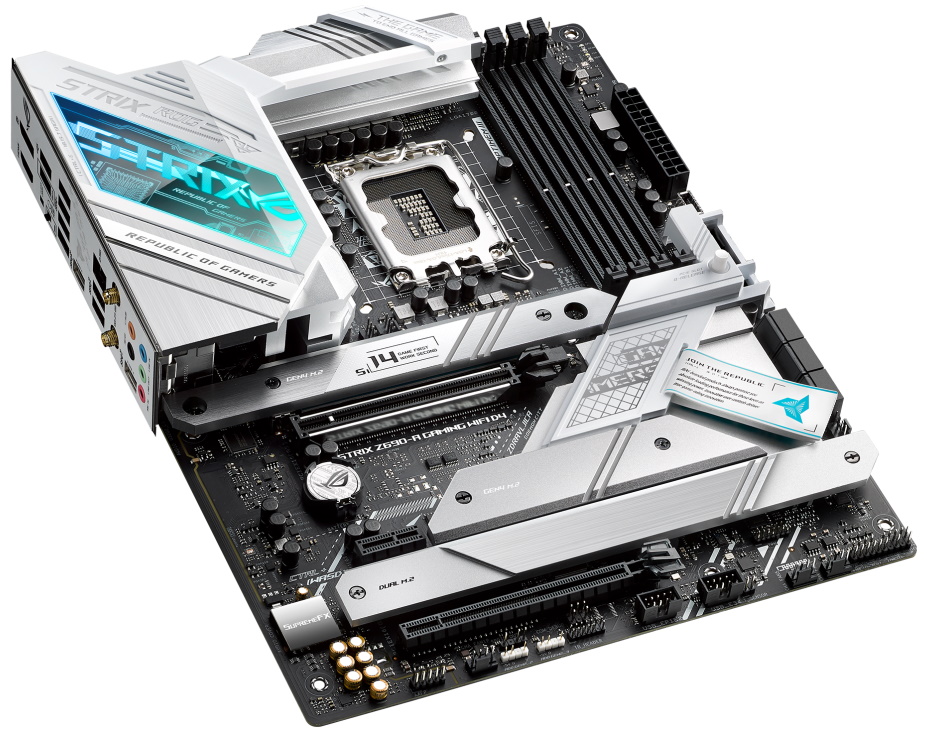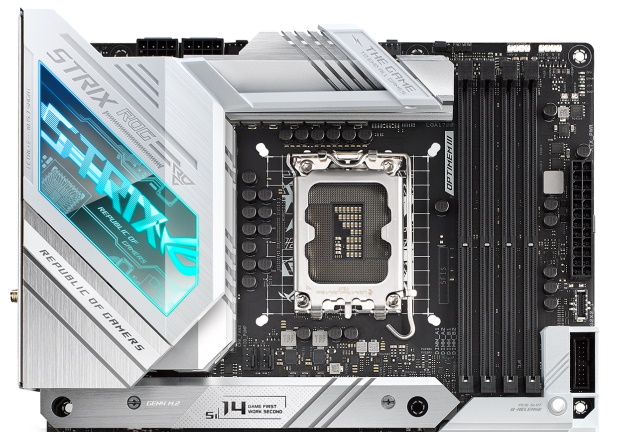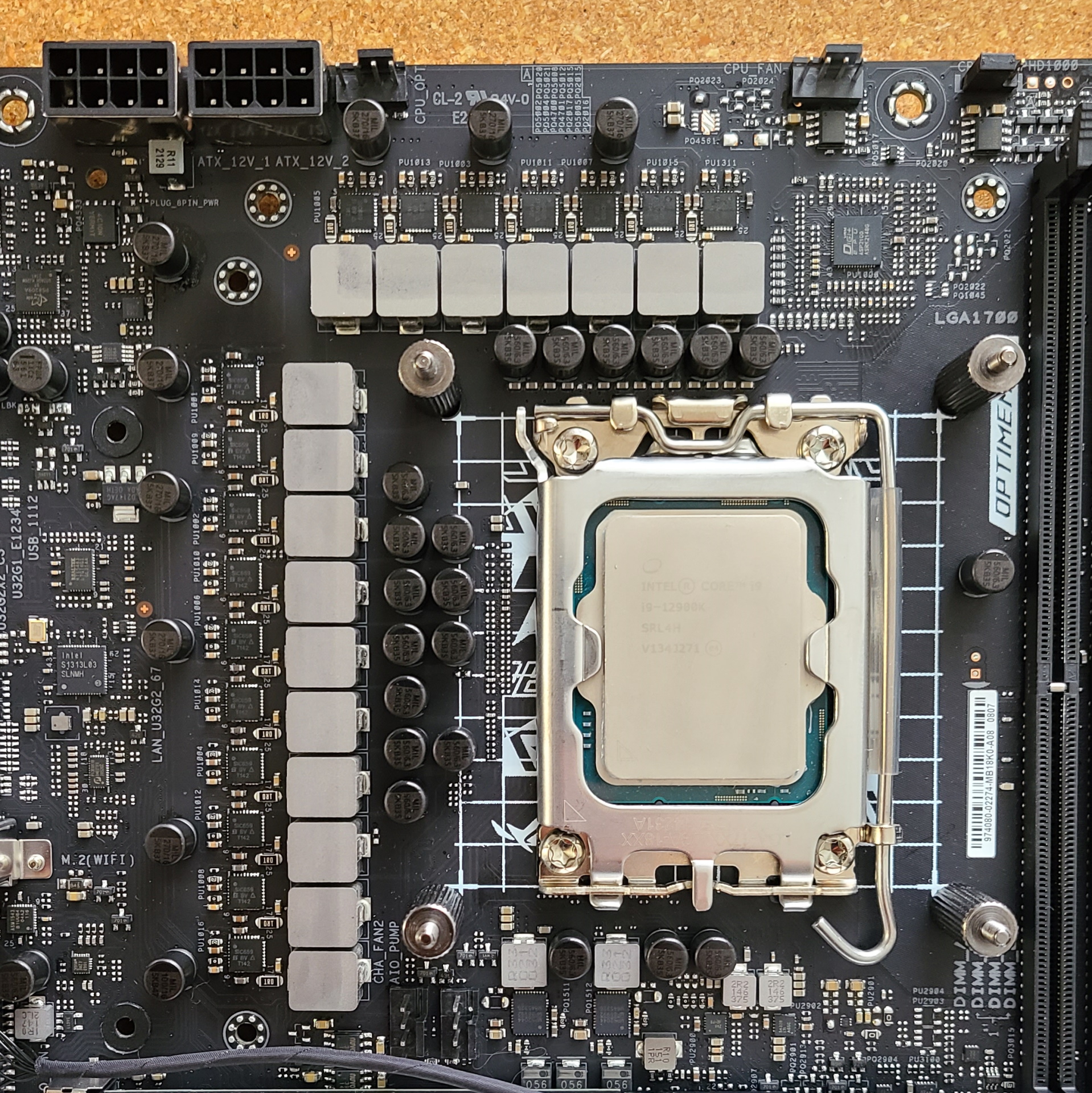Tom's Hardware Verdict
Asus’ ROG Strix Z690-A Gaming WIFI D4 is a well-rounded motherboard offering great performance and a nice black-on-silver look unique to ROG. But priced at around $320, it’s one of the most expensive Z690 DDR4 boards. There are less-expensive options available with similar specs.
Pros
- +
Four M.2 sockets
- +
PCIe Slot Q-Release
- +
Capable 80A VRMs
- +
Performed very well in testing
Cons
- -
High price for a DDR4 Z690 board
- -
Lacks Wi-Fi 6E
Why you can trust Tom's Hardware
For a couple of generations now, the mid-range ROG Strix ZXXX-A Gaming boards hit the market with a black and silver theme vastly different from Asus’ black-and-red ROG-themed boards. The Asus ROG Strix Z690-A Gaming WiFi D4 continues that tradition and offers quality hardware on top it. At a current price of around $320, it’s the least expensive entry point to Asus’ premium ROG line. The motherboard comes stocked with four M.2 sockets, high-quality audio bits, fast networking and Wi-Fi, capable power delivery, and is ready for any Alder Lake processor.
With the latest BIOS (1601), our Z690-A Gaming WIFI D4 performed very well in our testing suite. The Procyon Office test results are some of the fastest we’ve seen, and the board was above average across most of the rest. Gaming performance was also spot on compared to the other Z690- and B660-based motherboards. The Strix also overclocked our Intel Core i9-12900K without issue. Overall, this is a well-performing motherboard across a wide variety of benchmarks, and it doesn’t use much power in the process.
We’ll take a deep dive into the features to see what makes this board tick and see if this mid-range option finds a home on our best motherboards list or is even a worthwhile Z690 DDR4 option. But before that, here are the board’s detailed specifications, direct from the Asus website.
Specifications: Asus ROG Strix Z690-A Gaming WIFI D4
| Socket | LGA1700 |
| Chipset | Z690 |
| Form Factor | ATX |
| Voltage Regulator | 17 Phase (16+1 80A DrMOS MOSFETs for Vcore) |
| Video Ports | HDMI (v2.1) |
| Row 5 - Cell 0 | DisplayPort (v1.4 - 8K@60Hz) |
| USB Ports | (1) USB 3.2 Gen 2x2, Type-C (20 Gbps) |
| Row 7 - Cell 0 | (1) USB 3.2 Gen 2, Type-C (10 Gbps) |
| Row 8 - Cell 0 | (2) USB 3.2 Gen 2 (10 Gbps) |
| Row 9 - Cell 0 | (4) USB 3.2 Gen 1 (5 Gbps) |
| Row 10 - Cell 0 | (2) USB 2.0 (480 Mbps) |
| Network Jacks | (1) 2.5 GbE |
| Audio Jacks | (5) Analog |
| Legacy Ports/Jacks | ✗ |
| Other Ports/Jack | ✗ |
| PCIe x16 | (1) v5.0 (x16) |
| Row 16 - Cell 0 | (1) v3.0 (x4) |
| PCIe x8 | ✗ |
| PCIe x4 | ✗ |
| PCIe x1 | (2) v.3.0 (x1) |
| CrossFire/SLI | AMD 2-Way CrossFireX |
| DIMM Slots | (4) DDR4 5333+(OC), 128GB Capacity |
| M.2 Sockets | (1) PCIe 4.0 x4 (64 Gbps) / PCIe (up to 110mm) |
| Row 23 - Cell 0 | (1) PCIe 4.0 x4 (64 Gbps) / PCIe (up to 80mm) |
| Row 24 - Cell 0 | (1) PCIe 4.0 x4 (64 Gbps) / PCIe + SATA (up to 110mm) |
| Row 25 - Cell 0 | (1) PCIe 4.0 x4 (64 Gbps) / PCIe + SATA (up to 80mm) |
| Row 26 - Cell 0 | Supports RAID 0/1/5 |
| U.2 Ports | ✗ |
| SATA Ports | (6) SATA3 6 Gbps (Supports RAID 0/1/5/10) |
| USB Headers | (1) USB v3.2 Gen 2x2, Type-C (20 Gbps) |
| Row 30 - Cell 0 | (1) USB v3.2 Gen 1 (5 Gbps) |
| Row 31 - Cell 0 | (2) USB v2.0 (480 Mbps) |
| Fan/Pump Headers | (8) 4-Pin (CPU, CPU OPT, AIO Pump, Chassis) |
| RGB Headers | (3) AURA aRGB (3-pin) |
| Row 34 - Cell 0 | (1) RGB (4-pin) |
| Diagnostics Panel | (4) POST LEDs |
| Internal Button/Switch | ✗ |
| SATA Controllers | ✗ |
| Ethernet Controller(s) | Intel I225-V (2.5 GbE) |
| Wi-Fi / Bluetooth | Intel AX201 Wi-Fi 6 (2x2 ax, MU-MIMO, 2.4/5/6 GHz, 160 MHz, BT 5.2) |
| USB Controllers | ASMedia ASM1074 |
| HD Audio Codec | Realtek ALC4080 (w/ Savitech SV3H712 Amp) |
| DDL/DTS | ✗ / DTS Sound Unbound |
| Warranty | 3 Years |
Inside the Box of the Asus ROG Strix Z690-A Gaming WIFI D4
Inside the motherboard box are several accessories intended to get your system up and running without a trip to the store. While there’s nothing that stands out in this accessory stack, you’ll find SATA cables, Q-latch for M.2, the driver DVD, and more. Below is a complete list of the included accessories.
- (4) SATA cables
- Wi-Fi antenna
- Cable ties pack
- M.2 rubber package
- M.2 Q-Latch
- ROG Key chain/stickers
- Support DVD
- User Guide
Design of the Z690-A Gaming



The ROG Strix Z690-A Gaming WIFI D4 and it’s black and silver design are what I like to call an Asus one-off. All of the other ROG and ROG Strix boards sport the signature black-on-black/red theme, while this one looks more like their Prime series, but on steroids. Above the VRMs and rear IO area is a large heatsink with a cool-looking RGB feature on top with the ROG Strix branding shining through.
The rest of the 6-layer PCB, including the PCIe and DRAM slots, is black although the primary PCIe slot does use reinforcement and is silver. The heatsink covering the chipset also has a unique design with a velcro strip looping through the heatsink instead of your standard heatsink design. For those looking to buy a premium ROG-class motherboard but prefer a contrasting black-on-silver aesthetic, it’s a good alternative to the other ROG/Strix boards (that are also more expensive).
Starting at the top on the left side, we run into the two 8-pin EPS connectors (one required) that power the processor. The main feature is the large VRM heatsink with the unique RGB feature on top sporting a brushed aluminum finish around it. The heatsink has a lot of mass and surface area and is more than adequate to keep the power bits below running in spec.
Get Tom's Hardware's best news and in-depth reviews, straight to your inbox.
Above the top VRM heatsink are the first two (of eight) 4-pin fan headers. Here we find the CPU_FAN and CPU_OPT headers, with the rest scattered strategically around the board. All fan headers are Q-Fan controlled, minus the AIO_PUMP (full-speed) and output up to 1A/12W. There are plenty of headers to go around, but I would like to see at least one with increased output to piggyback some fans or power a more robust pump for custom water cooling.
Moving to the right, past the socket, we bump into four unreinforced DRAM slots that lock on both ends. The board supports up to 128GB of RAM, with speeds listed up to DDR4-5333(OC) – one of the higher values we’ve seen. Using our DDR4-4000 kit, we didn’t run into any issues, but reaching those speeds requires the right kit and a good IMC, so as always, your mileage may vary.
In white, just above the DRAM slots, are the first two (of four) RGB headers. Here we find spy a 3-pin Aura ARGB header and a 4-pin RGB header. Looking down the right edge, we run into the Q-LED feature that tells you if there is a problem during POST. Below that is the 24-pin ATX connector to power the board, a front panel USB 3.2 Gen 2x2 (20 Gbps) connector and a USB 3.2 Gen 1 (5 Gbps) header.
Another feature worth noting is the handy Q-Release button to unlock the PCIe slot. Often, there’s very little space to push the standard PCIe locking mechanism down, and that’s the case here. Grandet, most people don’t swap graphics cards or remove them with any frequency, but the buttom mechanism here is still helpful when you do.
Power delivery on the Z690-A Gaming WIFI D4 consists of 17-phases, with 16 dedicated to Vcore. Power comes from the EPS connectors to Asus’ DIGI+ VRM (ASP2100 10-channel controller) and then on to the 16 80A Vishsay SIC659 DrMOS MOSFETs. The 1,280 Amps available to the processor are plenty to overclock the flagship Intel Core i9-12900KS and we had zero issues overclocking our similarly power-hungry i9-12900K. As has been the case with Alder Lake, most of the time you’re limited by the cooling solution, not power delivery.
On the bottom half of the board, left, is the audio section, isolated from the rest of the board by the audio line shielding most boards have these days. Hidden under the chrome Faraday cage is the SupremeFX chip that’s based on the premium Realtek ALC4080 codec. Front panel output is handled by a Savitech SV3H712 amplifier, designed to drive a wide variety of headphones. This is one of the better audio implementations at this price point.
In the middle of the board are three PCIe slots and four M.2 sockets, each with heatsinks. Starting with the PCIe slots, there are two full-length slots on the board, with the reinforced top slot designated as the primary for graphics cards. The top slot connects to the CPU and runs at PCIe 5.0 x16 speeds, while the bottom full-length slot connects through the chipset and runs at PCIe 3.0 x4. The x1 slot in the middle also connects through the chipset and runs at PCIe 3.0 x1. This configuration supports AMD Crossfire technology.
Spread around and between the PCIe slots are four M.2 sockets, all of which have a heatsink to keep the warm-running devices cool. The top socket connects through the CPU and runs up to PCIe 4.0 x4 (64 Gbps), holding up to 110mm modules. The rest of the sockets connect through the chipset and run at a maximum of PCIe 4.0 x4. Furthermore, they all hold up to 80mm modules. M.2_4 supports PCIe and SATA storage. We like that flexibility, because many boards only support PCIe M.2 modules. If you want to RAID the NVMe, the Z690-A Gaming WIFI D4 supports RAID0/1/5 modes. Along the right edge are six SATA connectors that can run in RAID0/1/5/10 modes on the four native ports. The other two, SATA6G_E1-2 are supported by an ASMedia controller.
Across the bottom of the board are several exposed headers. You’ll find the usual, including additional USB ports and RGB headers here. Below is a complete list of headers, from left to right.
- Front panel audio
- 4-pin chassis fan header
- (2) 3-pin AURA ARGB headers
- Thunderbolt header
- (2) USB 2.0 headers
- 2-pin temperature sensor
- TPM header (above CHA fans)
- (2) 4-pin chassis fans
- Front Panel
The rear IO area comes with a pre-installed IO plate sporting a white background. The ports and branding are in black or grey, so they are easy to read. In total, there are 10 USB ports: a USB 3.2 Gen 2x2 (20 Gbps) Type-C and Gen 2 (10 Gbps) Type-C ports, four blue USB 3.2 Gen 2 (10 Gbps) ports, two (red) USB 3.2 Gen 1 (5 Gbps) ports and two USB 2.0 ports (the bottom is used for BIOS Flashback functionality. On the left are the video outputs, Displayport and HDMI. To the right and under the USB 2.0 ports are the BIOS Flashback and Clear CMOS buttons. Additional ports include the 2.5 GbE, the Wi-Fi 6 antenna connectors, and the 5-plug analog audio stack.
MORE: Best Motherboards
MORE: How To Choose A Motherboard
MORE: All Motherboard Content

Joe Shields is a staff writer at Tom’s Hardware. He reviews motherboards and PC components.
-
-Fran- It's a beautiful board, for sure. I like white accents on boards, more than other colours... I don't know why.Reply
Other than that, bog standard board? Slightly higher priced than the competition, but I guess they can justify it with their software.
Regards.



